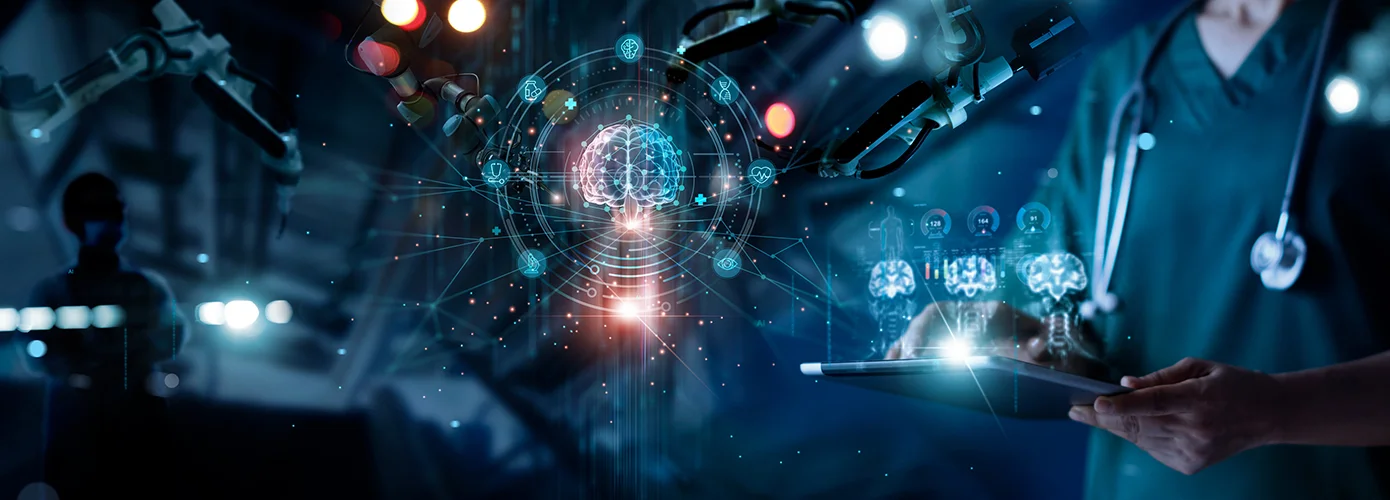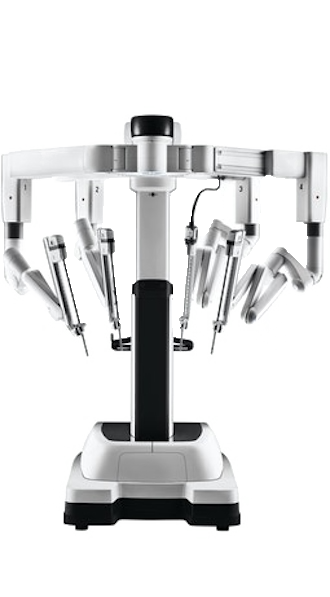

Bedah robotik, juga dikenal dengan pembedahan dengan bantuan lengan robot, adalah jenis bedah minimal invasif yang menggunakan sistem robotik untuk membantu dokter bedah melakukan prosedur yang kompleks dengan presisi, fleksibilitas, dan kontrol yang lebih baik dari teknik bedah konvensional.
Bedah robotik memiliki beberapa komponen, seperti:

The Mako Robotic-Arm Assisted Surgery System combines advanced imaging technology with robotic assistance, enabling orthopaedic surgeons to create customised surgical plans tailored to each patient’s unique anatomy.
This system supports a range of robotic orthopaedic surgeries, including Robotic Knee Replacement (both Partial and Total Knee Replacement or Arthroplasty) as well as Hip Arthroplasty.



The da Vinci Xi system’s central feature is its 3D high-definition visualisation, which provides our surgeons with an exceptional view of the surgical field. This crystal-clear visualisation allows for precise navigation through complex anatomy, enabling surgeons to perform even the most intricate procedures with confidence and ease.
The versatility of the da Vinci Xi system extends across a wide range of surgical specialties, including Urology, Gynaecology, General Surgery, Thoracic Surgery, and ENT. Notably, urologic surgeries, such as Robotic Prostate Surgery (Robotic Prostatectomy), leverage the advanced capabilities of the da Vinci Xi system.
Menggunakan sistem robotik itu seperti jika dokter bedah memiliki alat bedah canggih di tiap ujung jarinya. Lengan robotik dilengkapi dengan alat bedah dalam ukuran kecil yang dapat bergerak dengan lebih fleksibel dan lebih presisi dibandingkan tangan manusia.
Misalnya, dengan menggunakan tampilan 3D anatomi tulang berbasis CT scan, dokter bedah dapat menggunakan Sistem Mako untuk membuat rencana bedah yang dipersonalisasi, serta mengidentifikasi langkah-langkah pembedahan dan penyesuaian yang dilakukan berdasarkan anatomi tubuh tiap pasien.
Salah satu keunggulan utama bedah robotik adalah kemampuan untuk melakukan bedah minimal invasif. Alih-alih membuat sayatan yang besar, dokter bedah dapat membuat beberapa sayatan kecil, sehingga mengurani dampak buruk pada tubuh pasien, dan sering kali mempersingkat waktu pemulihan.
Dokter bedah yang menggunakan teknik bedah robotik dapat memiliki visualisasi 3D dan berdefinisi tinggi dari area pembedahannya. Visualisasi ini mampu memberikan tampilan anatomi tubuh yang lebih detail dan bisa diperbesar, sehingga memungkinkan gerakan yang lebih akurat dan lebih terkendali selama berjalannya prosedur.
Biasanya, dokter bedah hanya mengacu pada pencitraan 2D untuk memandu langkah-langkahnya dan mengidentifikasi struktur penting dalam pembedahan. Dengan Sistem da Vinci, dokter bedah dapat mengatasi masalah persepsi kedalaman dan spasial lewat tampilan 3D area pembedahan dalam waktu nyata (real-time).
Lengan robotik didesain untuk menyerupai gerakan tangan dan pergelangan tangan manusia, namun dengan tingkat kebebasan gerak yang lebih tinggi. Kemampuan manuver ini memungkinkan dokter bedah untuk menggapai area yang sulit dicapai lewat teknik bedah konvensional
Penelitian telah menunjukkan bahwa pembedahan yang dilakukan dengan lengan robot dapat mengurangi darah yang keluar, komplikasi, dan waktu rawat inap. Hal ini dapat memberikan hasil yang lebih baik bagi pasien dan waktu pemulihan yang lebih singkat sebelum kembali beraktivitas.
Inti dari layanan kesehatan adalah komitmen untuk mendahulukan kepentingan pasien. Dedikasi ini akan mendorong sektor teknologi medis untuk terus berinovasi dan menciptakan alat-alat tercanggih yang didesain untuk mendukung layanan terbaik yang dapat diberikan rumah sakit dan tenaga kesehatan profesional. Tujuannya sederhana, yaitu meningkatkan hasil pembedahan bagi semua pasien.
Sistem bedah robotik, seperti Sistem Bedah da Vinci dan Mako SmartRobotics, memungkinkan dilakukannya teknik bedah minimal invasif yang membuat dokter bedah dapat melakukan operasi dengan lebih cermat dan tidak merusak tubuh. Sayatan-sayatan yang lebih kecil juga mengurangi nyeri dan mempersingkat waktu pemulihan, memungkinkan kondisi Anda kembali optimal dengan cepat.
Selain itu, sistem bedah robotik juga meningkatkan kemampuan dokter bedah Anda. Bayangkan asisten bedah dengan tingkat presisi dan ketangkasan yang tak terkalahkan dan teknologi yang canggih, yang memungkinkan dokter bedah melakukan prosedur dengan kontrol dan akurasi tinggi.
Bedah robotik kini semakin dikenal di berbagai spesialisasi bedah. Metode ini menawarkan visualisasi dan ketangkasan yang lebih baik, dan lebih ergonomis, dibandingkan teknik bedah konvensional, serta memungkinkan prosedur yang minimal invasif. Masalah mengenai biaya dan waktu yang diperlukan untuk terbiasa menggunakan sistem ini akan terbayar dengan kemajuan teknologi dan adopsi sistem yang lebih tinggi di skala global. Peningkatan teknologi umpan balik taktil (haptik) serta penelitian lebih lanjut mengenai keunggulan sistem bedah robotik dibandingkan teknik bedah konvensional menjadi hal yang penting untuk mendorong kemajuan praktik ini.

